History of English Wool
English wool generated a lot of wealth for the merchants. Traded from Bruges to Venice, a product taxed by Kings and in demand across Europe. Click through to read more.n An Antipodean travel company serving World Travellers since 1983 with small group educational tours for senior couples and mature solo travellers.
15 Dec 22 · 9 mins read

History of English Wool
Wool plays a significant role in England’s history and heritage. Sheep, along with Neolithic shepherds, first migrated to the British Isles around 6,000 years ago, and it didn’t take long before their wool was being extracted to make cloth. A thriving wool industry then existed under the Romans, and the wool trade was a fundamental part of the medieval English economy. Over its long history, English wool has helped to start wars, drive large-scale migration, form English culture and language, and fund some of the country’s grandest architecture.
This article explores the history of sheep and the wool trade in England, intended as background reading for Odyssey Traveller’s small group tours to England for mature and senior travellers. We explore the medieval history of English wool during our 22-day Medieval England Tour and our 22-day Seven Ages of Britain Tour. During both these tours, we visit Lavenham in Suffolk, widely regarded as the best example of an English medieval wool town. The prosperous wool merchants here were responsible for most of the town’s most memorable buildings, including the church of St. Peter and Paul, perhaps the finest “wool church” in the land. Read on to learn more!
Much of the information used in this article is sourced from Robert Winder’s The Last Wolf.
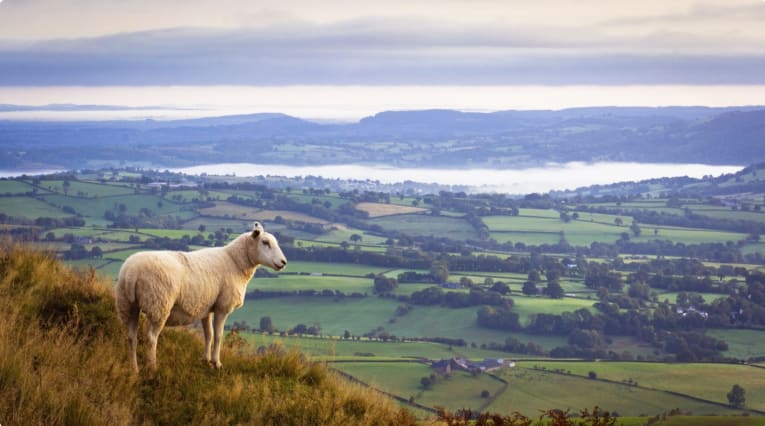
English Wool in Prehistoric and Ancient History
Archaeological evidence reveals that primitive tribes were breeding domesticated sheep across Northern Europe from as early as 6,000 BCE. Soon, neolithic shepherds, with the help of the first sheepdogs, began to migrate the sheep into new lands, eventually reaching the British Isles around 4,000 BCE. By around 1900 BCE, a few cunning humans had learnt how to twist and knot the wool into rough cloth.
The discovery of iron then transformed farming by giving people much stronger tools. This allowed for practices such as shearing to emerge from around 500 BCE. Soon clothes fabricated from wool, rather than pelts and furs, also began to appear. Winder writes, “It was rudimentary (sustenance weaving) but it was the kernel in which the textile industries of the future began to be hatched.”
By the time the Romans conquered Britain in 55 BCE, there already existed a thriving wool industry, with British woven cloth considered a luxury item. The Romans then further encouraged the industry, establishing a wool plant in Winchester in 50 CE and further developing the methods of skilled British weavers. Before long wool had come Britain’s most valuable commodity, with the Romans fetching top prices for the high-quality product in foreign lands.
Medieval English Wool Trade
With the fall of the Roman empire the wool trade died down, with the sheep of Anglo-Saxon England kept for their milk rather than their fleeces. Nevertheless, the English climate had made a significant impact on the quality of the local wool. Through the process of evolution and natural selection, the wool had become unusually long and strong, but also soft and thick. By the time of the Norman Conquest, it was the finest raw material for cloth in the world.
The Normans realised this immediately. There was only one problem: large numbers of wolves across England were making it impossible to adequately protect the sheep. The predators needed to be exterminated. So, between 1066 and 1152 CE, Norman Kings employed servants as wolf hunters and often organised wolf-hunting parties. By the early 1200s, King John (r. 1199 – 1216) was offering a sizeable reward for the capture of wolves – at 5 shillings a pelt. Edward I (r. 1272 – 1307) went even further, ordering the total extermination of all wolves in his kingdom. Entire woodlands were cut down for this reason.
The culling was successful. Wolves had become very rare by the late medieval period, and by the 15th century they were extinct. England had successfully been turned into a giant sheep farm, which in turn had created a new sort of economy and society.
Already by the 13th century, an enormous demand for wool, mainly to produce cloth, was driving the English economy. Wherever there was land, there was sheep – owned by everyone from peasants to big landowners. Even the Church was involved, with many monasteries organising grazing lands efficiently, pioneering breeding techniques, and taking an active part in the wool trade.

It had become agriculture on an industrial scale, with England as Europe’s pre-eminent wool producer. The English wools, particularly from the Welsh Marches, the Southwest, and Lincolnshire, were exported to France, Italy, and the Low Countries, where it was spun into finished clothes. The best weavers, who lived in the cloth-making capitals of Bruges, Ghent, and Ypres, were especially willing to pay top prices for the quality English wool. This fostered the growth of ports like Hull, King’s Lynn, and Southampton, from where the fleece would be shipped to the cloth-working centres.
Because England controlled the production of wool, it had power over the whole weaving industry. Realising this, King Edward I imposed heavy taxes on the industry in order to fund his wars and crusades. Successive monarchs would follow suit. King Edward III (r. 1313 – 1377), in particular, was encouraged to go to war with France with the knowledge England was better resourced, resulting in the Hundred Years’ War (1337 – 1453). The cause of the Hundred Years’ War in itself was partly to protect the Flanders wool trade, with burghers from the rich Flemish cloth-towns appealing to Edward III for help against their French overlords.
However, the taxes levied on the wool trade to finance this war were so heavy they actually began to damage the trade, with wool becoming unaffordable for the Flemish. Ultimately, this led to the production of more cloth in England itself, especially as Flemish weavers, fleeing war and French rule, migrated there. Their migration was encouraged by Edward III, with many Flemish settling in small country villages and towns in Norfolk, Suffolk, the West Country, the Yorkshire Dales, and Cumberland. These areas would become the flourishing centres of the wool industry, utilising the expertise learnt from the Flemish weavers to produce first-rate woollen cloth.
By the 15th century, England was producing so much cloth that, satisfying its own needs, it had also started selling the materials abroad. This was bolstered in the sixteenth century, as Huguenot weavers, persecuted under the French, also migrated to England, bringing further knowledge and skills. The industry became so successful that by the end of the 17th century, wool cloth made up two-thirds English exports’ value.
The Wool Industry in the Modern Era
New mechanical processes for spinning and weaving were invented during the Industrial Revolution of 1750-1850. This led to the rapid development of mills in the north of England, where there were steep hills and plenty of water to power the mills.
Cities such as Leeds and Bradford dominated the industry, with their mechanised mills and transport routes feeding ever-expanding trade to the growing British Empire. The mills were the biggest the world had ever seen. The largest was the Salts Mills in Shipley, near Bradford, which had 1200 looms creating 30,000 yards of cloth a day. Bradford would become the centre for trading raw wool, its wool exchange still one of the most spectacular buildings in England.
Increasingly large amounts of raw materials, meanwhile, were shipped into Leeds from across the ever-expanding British Empire, coming from as far away as Australia and New Zealand. The Leeds-Liverpool canal connected Leeds to the coast and was utilised almost exclusively to transport wool and cloth traded around the world.
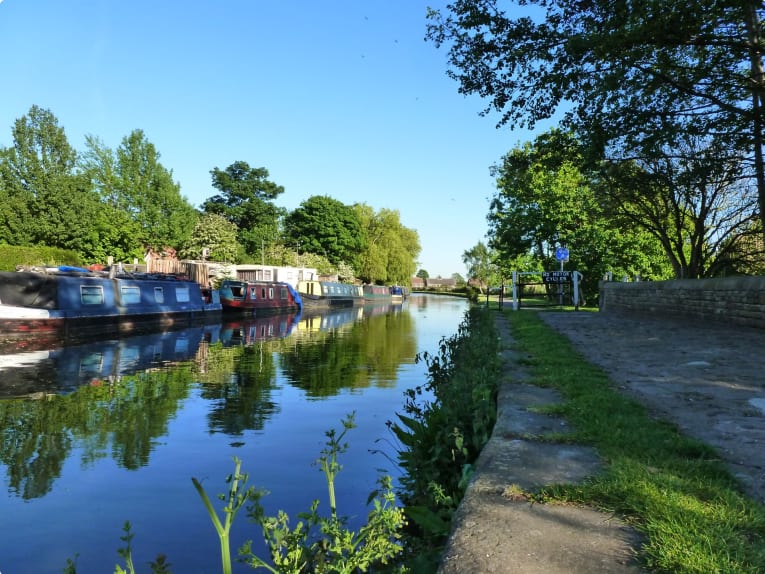
British wool production did not just occur in England. Wealthy landowners and farmers in Wales and Scotland also recognised the huge profits they could make from sheep farming. This impacted on Scotland in particular, leading to some of the country’s darkest days. Through a process known as the ‘Highland Clearances’, between 1750 and 1860, Scottish landowners forcibly removed tenants and holdings from their Highland Estates, destroying their dwellings and other buildings, in order to convert the land into sheep farms. This caused a great famine and entire communities perished. The situation became so disastrous that thousands of Scots were forced to flee, seeking refuge in the New World along the east coast of Canada and America.
British mills and the global trade continued well into the twentieth century, until Asia took over the market with cheaper imports of fabrics form the early 1960s. Nevertheless, the British wool industry continues today, producing 40 million of fleece served by 40 operational mills annually. The wool remains valued for its high quality and continues to fetch the highest price.
The Impact of Wool on England
The consequences of the wool industry for England were significant. Winder writes that the industry in the Middle Ages “was the foundation stone for all subsequent English history”. It introduced the country to large-scale commerce, to fairs and markets, and it financed the construction of fine churches, guild halls, and granaries in towns and villages. It also changed the countryside forever, transforming the landscape into a giant pasture, as forests were felled and turned into meadows and thousands of acres of common land were enclosed to make sheep runs.
The most important consequence of sheep-rearing, however, was that it created the first solid accumulation of wealth. Of course, it was the merchants, rather than the shepherds who benefited most handsomely from the proceeds of the wool trade – but the profits did spill over, as can be seen in the cathedrals, abbeys, castles, gatehouses, dovecotes, tithe barns and chapels that adorn the English countryside to this day. The pools of capital would also eventually be invested in the next phases of commercial enterprise, influencing manufacturing, slavery, industry, and empire.
Wool also created the conditions that the supported the social and commercial organisations of later English life. Winder argues it influenced “systems of landownership and law, mechanisms for settling disputes, political institutions, schools (to produce an educated middle class of administrators, scientists and financiers) and all the ancillary trades and services (such as transport and storage) that were needed to keep the show on the road”.
Wool’s importance to England is also reflected in the fact that since the fourteenth century, the British Lord Chancellor has sat on a chair stuffed with wool, known as the Woolsack. Shepherds have also played an important role in the country’s history, making up several of its saints and bishops. Even cricket – a defining national pastime – was invented by playful shepherds.
Unsurprisingly, given the extent of farming, sheep have made their way into every aspect of England’s language, literature, art, architecture, and philosophy. Still today allusions to sheep are found in everyday language. The English talk of sacrificial lambs and pastures new. They still refer to God as their shepherd watching over his flock by night. They ‘separate the sheep from the goats’ when deciding what to keep and what to throw away. They ridicule ‘mutton dressed as lamb’, sigh over the ‘black sheep of the family’, and ‘have the wool pulled over their eyes’. And they eat a shepherds’ pie and weave a narrative thread. In various aspects of speech there is the reminder of wool’s prominent role in their sheepish past.
Tour of England
Odyssey Traveller explores the history of English wool during our 22-day Medieval England Tour and our 22-day Seven Ages of Britain Tour, both of which visit the English medieval wool town of Lavenham in Suffolk.
Our Medieval England Tour has been especially designed for the active mature-aged and senior traveller, joining this tour as a couple or solo traveller with an interest in exploring what remains of Medieval England and Wales. On this worthwhile journey, we will discover how those years laid the foundation for modern Britain. We’ll concentrate on the period between AD 800, around seven centuries after Hadrian’s Wall was erected to mark the northern limit of Britain, and AD 1500. We will discover–through guided tours of medieval castles and cathedrals, sightseeing tours of the beautiful landscapes and natural beauty of the British Isles, and walking and city tours to view the modern world–just how much the country has changed over the centuries.
Our Seven Ages of Britain Tour examined seven formative periods of British history in an attempt to discover how the past informs the present. We begin in Orkney, Scotland, where we stroll through some of Europe’s best-preserved Neolithic and Viking monuments, before flying south to Newcastle, England and then travelling on through the quaint villages and hidden gems of York and Cambridge, before ending in London for a further exploration of the wonders of the United Kingdom’s capital.
Odyssey Traveller has been serving global travellers since 1983 with educational tours of the history, culture, and architecture of our destinations designed for mature and senior travellers. We specialise in offering small group tours partnering with a local tour guide at each destination to provide a relaxed and comfortable pace and atmosphere that sets us apart from larger tour groups. Tours consist of small groups of between 6 and 12 people and are cost inclusive of all entrances, tipping and majority of meals. For more information, click here, and head to this page to make a booking.
Articles published by Odyssey helping to prepare for your England Tour
The following list of articles published by Odyssey Traveller for mature aged and senior travellers to maximise their knowledge and enjoyment of England when visiting;
- Medieval British life
- Great Britain Travel tips
- Understanding British Churches
- English Village History
- Britain’s National Trust.
External articles to assist you on your visit to England
Related Tours

22 days
Apr, AugSeven Ages of Britain, snapshots of Britain through the ages.
Visiting England, Scotland
This guided small group tour starts in Scotland and finishes in England. On Orkney we have a day tour to the UNESCO World heritage site, Skara Brae, before travelling to city of York. Your tour leader continues to share the history from the Neolithic to the Victorian era. The tour concludes in the capital city, London.
From A$15,995 AUD
View Tour
22 days
Apr, SepSmall group tours Medieval England
Visiting England
A small group tour of England focused on Medieval England and Wales. Spend 21 days on this escorted tour with tour director and local guides travelling from Canterbury to Cambridge, passing through Winchester, Salisbury, Bristol, Hereford and Norwich along the way. Castles, villages, Cathedrals and churches all feature in the Medieval landscapes visited.
From A$14,665 AUD
View Tour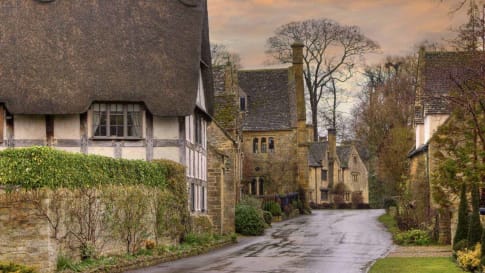
19 days
Jun, SepEngland’s villages small group history tours for mature travellers
Visiting England
Guided tour of the villages of England. The tour leader manages local guides to share their knowledge to give an authentic experience across England. This trip includes the UNESCO World heritage site of Avebury as well as villages in Cornwall, Devon, Dartmoor the border of Wales and the Cotswolds.
From A$16,995 AUD
View Tour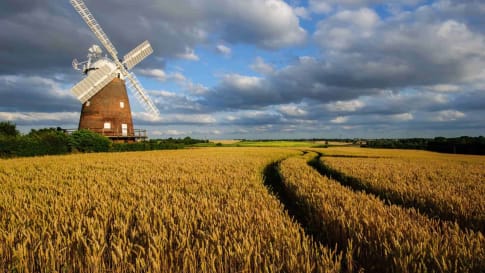
23 days
AprAgrarian and Industrial Britain | Small Group Tour for Mature Travellers
Visiting England, Wales
A small group tour of England that will explore the history of Agrarian and Industrial period. An escorted tour with a tour director and knowledgeable local guides take you on a 22 day trip to key places such as London, Bristol, Oxford & York, where the history was made.
From A$17,275 AUD
View Tour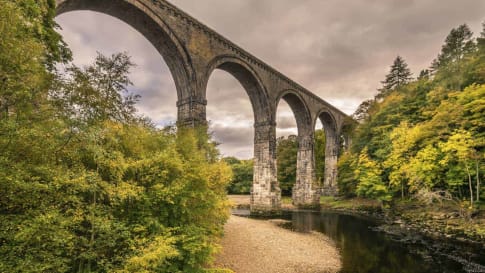
23 days
Oct, Apr, SepCanals and Railways in the Industrial Revolution Tour | Tours for Seniors in Britain
Visiting England, Scotland
A small group tour of Wales, Scotland & England that traces the history of the journey that is the Industrial revolution. Knowledgeable local guides and your tour leader share their history with you on this escorted tour including Glasgow, London, New Lanark & Manchester, Liverpool and the Lake district.
From A$17,860 AUD
View Tour
22 days
Sep, JunRural Britain | Walking Small Group Tour
Visiting England, Scotland
A walking tour into England, Scotland and Wales provides small group journeys with breathtaking scenery to destinations such as Snowdonia national park , the UNESCO world heritage site Hadrians wall and the lake district. each day tour provides authentic experiences often off the beaten path from our local guides.
From A$15,880 AUD
View Tour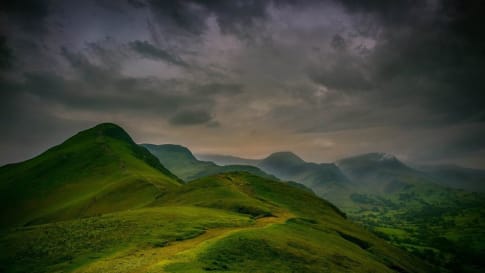
25 days
Sep, MarYorkshire, Northumberland and the Lake District
Visiting England
Small group tour for senior couples and mature solo travellers exploring Northern England. Not just the historic cities of Leeds, Newcastle and Manchester but the Viking shaped landscapes, villages and the Lake District are visited on this program.
From A$18,275 AUD
View Tour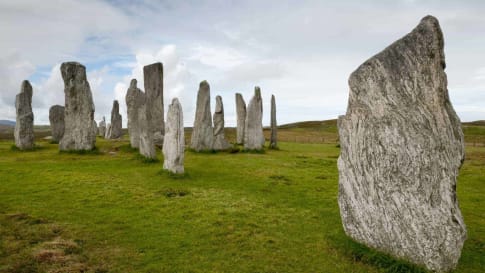
21 days
AugPrehistoric Britain small group history tour including standing stones
Visiting England, Scotland
This guided tour invites you to explore UNESCO World heritage sites at Skara Brae in the Orkneys, Isle of Skye, and Stonehenge in a prehistoric tour. This escorted tour has trips to key sites in Scotland, and the Irish sea in Wales such as Gower Peninsula and National Museum in Cardiff and England. Each day tour is supported by local guides.
From A$16,750 AUD
View Tour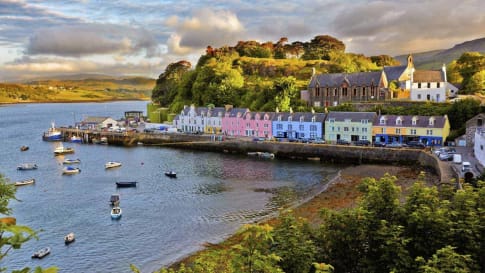
20 days
May, Jul, Aug, SepScottish Islands and Shetland small group tours for seniors
Visiting Scotland
An escorted small group tour for couples and solo travellers of the Scottish isles including the isle of Skye draws on local guides to share their knowledge of the destinations in this unique part of Scotland. UNESCO world heritage site are visited as breathtaking scenery and authentic experiences are shared in a group of like minded people on this guided tour of remote Scotland.
From A$17,525 AUD
View Tour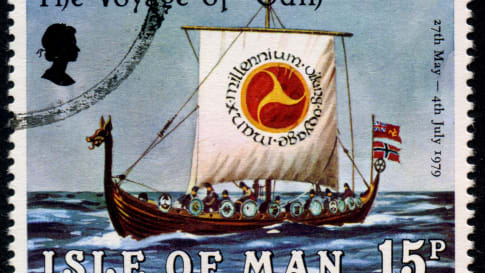
28 days
Jun, Sep, May, AugVikings in Britain; small group tour
Visiting England, Ireland
Vikings in Britain, escorted educational small group tour for senior couples and mature solo travellers who for 27 days explore Ireland, the isle of Man, Scotland and England and the viking history.
From A$20,385 AUD
View TourRelated Articles
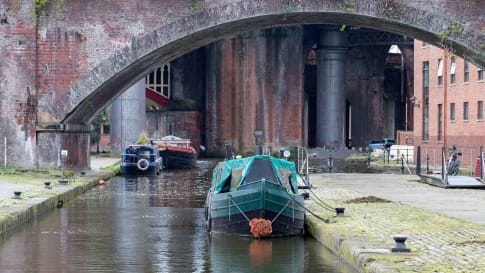
Britain: First Industrial Nation
Britain: The First Industrial Nation In the mid-18th century, the Industrial Revolution was largely confined to Britain. Historians and economists continue to debate what it was that sparked the urbanisation and industrialisation that would change…

British Village Icons: Definitive Guide for Travellers
Icons of the British Villages: Pubs and Cottages The British pub and cottage figure prominently in the image of a (often romanticised) quintessential “British village”. In this article, we will give special attention to these…

Discovering Medieval Chester: A Thriving Trade Centre
Article about Chester, England for small group educational tours for senior couple and mature solo travellers to England. Articles to support your travel plans to explore England, Scotland, Wales and Ireland.

English Village History
An English Village history. Prepared for mature and senior travellers, couples or solo traveller considering joining a small group tour of England's villages.
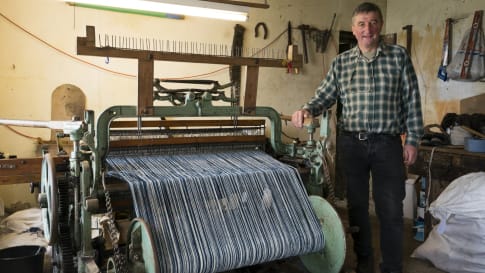
Harris Tweed - a story
A cloth only woven on the Outer Hebrides of Scotland. Enjoy a small group educational tour for senior couples and mature solo travellers to learn more about this craft and much more on a Scottish isles tour.

Lumps and Bumps: How to Read the British Landscape
The British landscape has been worked and re-worked. It is secrets of this palimpsest landscape is revealed through drainage patterns and prehistoric features all the way through to the modern day. These small group tours for mature and senior travellers examine the landscape from the Neolithic, to Roman, through the seven ages of Britain in walking tours and history tours of Britain.

Medieval British Village Life: The Definitive Guide for Seniors
Life in the Medieval British Village In a previous article, we looked at the icons of the British village–the pub and the cottage–and looked at their history and evolution from Roman and Norman times. In…
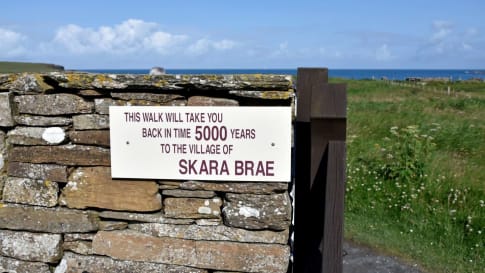
Skara Brae, Scotland
Article introducing Neolithic Britain and the trading routes to Iceland, the Faroe Islands and the Irish sea. Skara brae is included on the Scottish isles tour and the Prehistoric Britain program. Small group tours for senior couples and mature solo travelers.
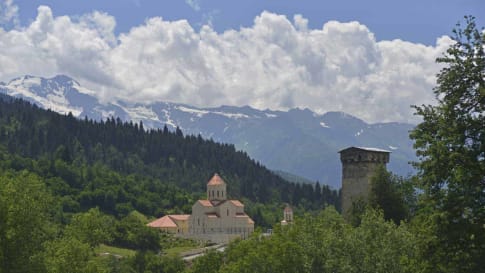
Clothes began in Georgia | History of clothing
For small group tour of mature and senior travellers touring Europe, this article provides an insight into the origin of textiles and fabric from Georgia in the Caucasus, to the Roman Empire and Southern Italy and Rome through to the industrial revolution of Britain.



